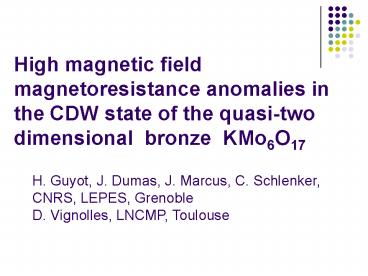Transition sous champ magn PowerPoint PPT Presentation
1 / 24
Title: Transition sous champ magn
1
High magnetic field magnetoresistance anomalies
in the CDW state of the quasi-two dimensional
bronze KMo6O17 H. Guyot, J. Dumas, J. Marcus,
C. Schlenker, CNRS, LEPES, Grenoble D.
Vignolles, LNCMP, Toulouse
2
Outline
- Introduction
- KMo6O17 CDW instability, hidden nesting
- Magnetoresistance
- Shubnikov-de Haas oscillations
- Angular dependence
- B-T phase diagram
- Discussion Competition between orbital effects
et Pauli coupling. Two regimes qlt45, qgt45. - Conclusion
3
KMo6O17 Layered crystal structure ? 2D
properties
4
Resistivity
Strong anisotropy r // c / r ?c
1000 Metal-metal transition Commensurate
charge density wave
Tp110K
5
Fermi surface from tight binding calculations
M.H. Whangbo, E. Canadell, P. Foury, J. P.
Pouget (1991)2D tight binding model
Individual Fermi surfaces from 3 bands
Idealized FS shows strong nesting (hidden
nesting) Zigzag chains a, b, (ab)
6
Hysteresis 20T lt Blt 40T SdH oscillations Bgt40T
Interlayer magnetoresistance vs B at different
temperatures
7
Interlayer magnetoresistance ??/?O vs B
for different tilt angles ? between the magnetic
field and the normal to the layers
c
?0 zero field resistance. T 1.5 K
8
Resistance vs Bfor different tilt angles ?
between the magnetic field and the normal to the
layers. T2.2KNew behavior qgt45
9
Inverse normalized fields vs q Bi follow a
1/cosq law (qlt55)
10
R(Bcosq) normalized at the values measured at B2
q 45 , 55 background superimposed
11
R(B) curves for q90 (B in the layers) and
q0 (B ? layers)No anomalies no sign of
saturation for q90T2.2K
12
Phase diagram T(B) B//c
13
Discussion
T lt 20K CDW/SDW ?
B gt 25T density wave state with smaller
gaps Gaps partially closed above 25 T.
14
Discussion
- Hysteresis 2 phase transitions (B3, B4) (first
order) - for B gt 25T (at 1.6K)
- Analogy with the kink transition
- in quasi-2D salts (BEDT-TTF)2(SCN)4
- New phase SdH oscillations for B gt 40T
- Orbital effects for B lt 25T better nesting
- Pauli type effects for B gt 25T anti-nesting
- Two regimes R(q) q lt 45 transitions and
anomalies determined by the field component Bz
Bcosq ? to the layers. - q gt 45 new additional background
contribution. - q 90 new behavior open orbits in a plane ?
layers.
15
1D Model, Zanchi, Bjelis, Montambaux (1996)
- 2 parameters
- h q orb / q Pauli
- Orbital coupling
- q orb ebH.cos q
- Pauli coupling
- q Pauli mBH / vF
- n -USDW / UCDW
2D Fermi Surface would include gaps smaller than
the average one (110K) H would act on these
special portions of the FS.
16
Conclusion
- KMo6O17
- -Competition between orbital and Pauli effects
- B lt 25T Orbital effects, better nesting (more
1D) - B gt 25T New CDW/SDW state with smaller gaps
- Pauli type effects
( anti-nesting ) - -Phase diagram B-T
- -Non monotonous angular dependence two regimes
are identified. - -AMRO?
17
Resistance vs temperature for different fields
No noticeable change of Tp with magnetic field
18
Normalized magnetic fields corresponding to the
3 extrema of the curve of ? ? / ?O and to
the second lowest field SdH oscillation vs angle
?
T1.5K
19
Peierls transition (1D)
T gt Tp
r(r) r0 r1 cos(2kf r f) u A sin(2kf r f)
T lt Tp
20
Amplitude of the SdH oscillations plotted as Ln
(A/T) vs T
Insert Reciprocal field 1/Bn corresponding to
the maxima of the high field oscillations vs an
integer n
21
Shubnikov-de Haas oscillations
- Frequency of the oscillations obtained from the
Onsager relation 1/Bn (2 e/?) (?/AF) (n1/2)
- F 600 ? 40 T
- Related area of the extremal orbit on the Fermi
surface 5.4 x10-2 Å-2 - 3.6 of the 2D high temperature Brillouin zone
22
Shubnikov-de Haas oscillations
- Amplitude of the oscillations A a Rt
- Rt thermal factor
- Rt x/sinh(x) with x2p?2mkT/ moe?B
- (p order of the harmonic)
- ? Cyclotron mass m 0.6 0.1m0
23
In-plane resistivity under a magnetic field
B//c
24
anisotropy of SdH oscillations second lowest
field SdH oscillation m0.6m0

